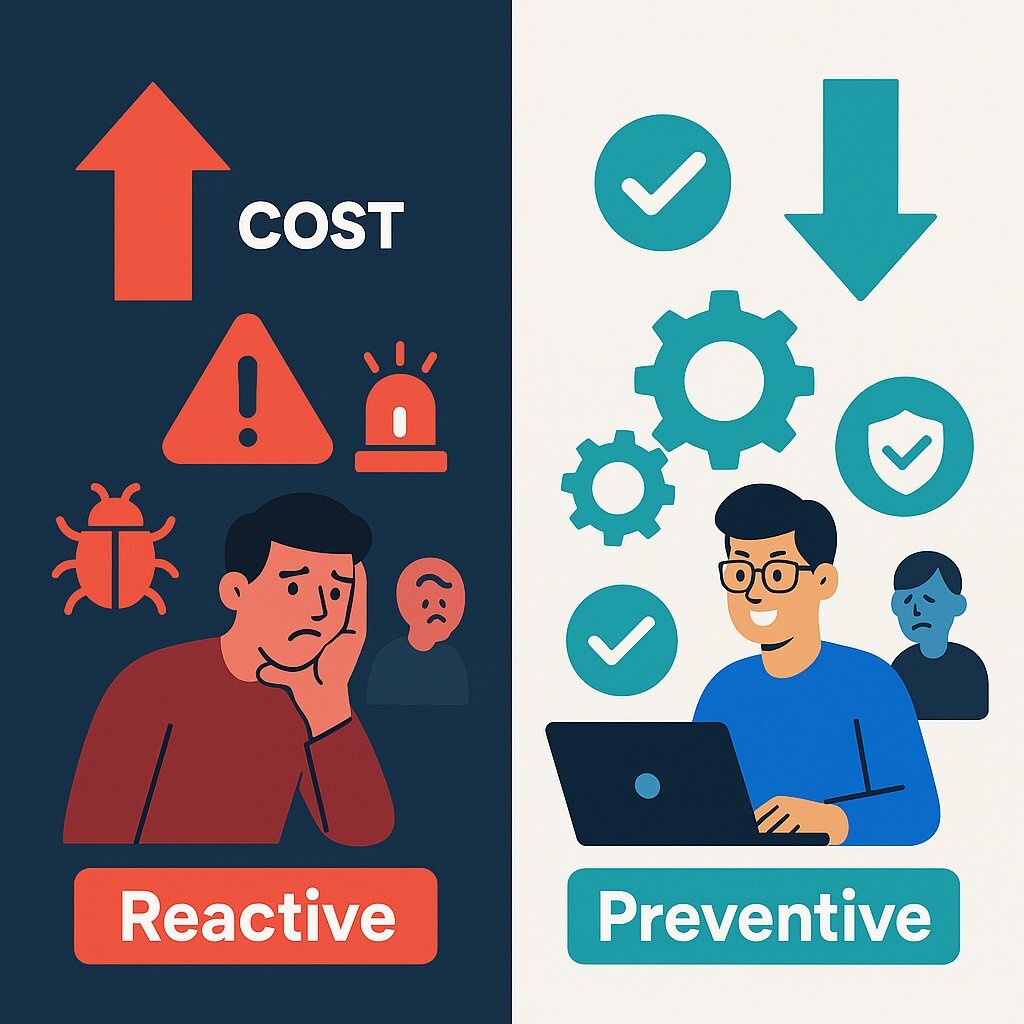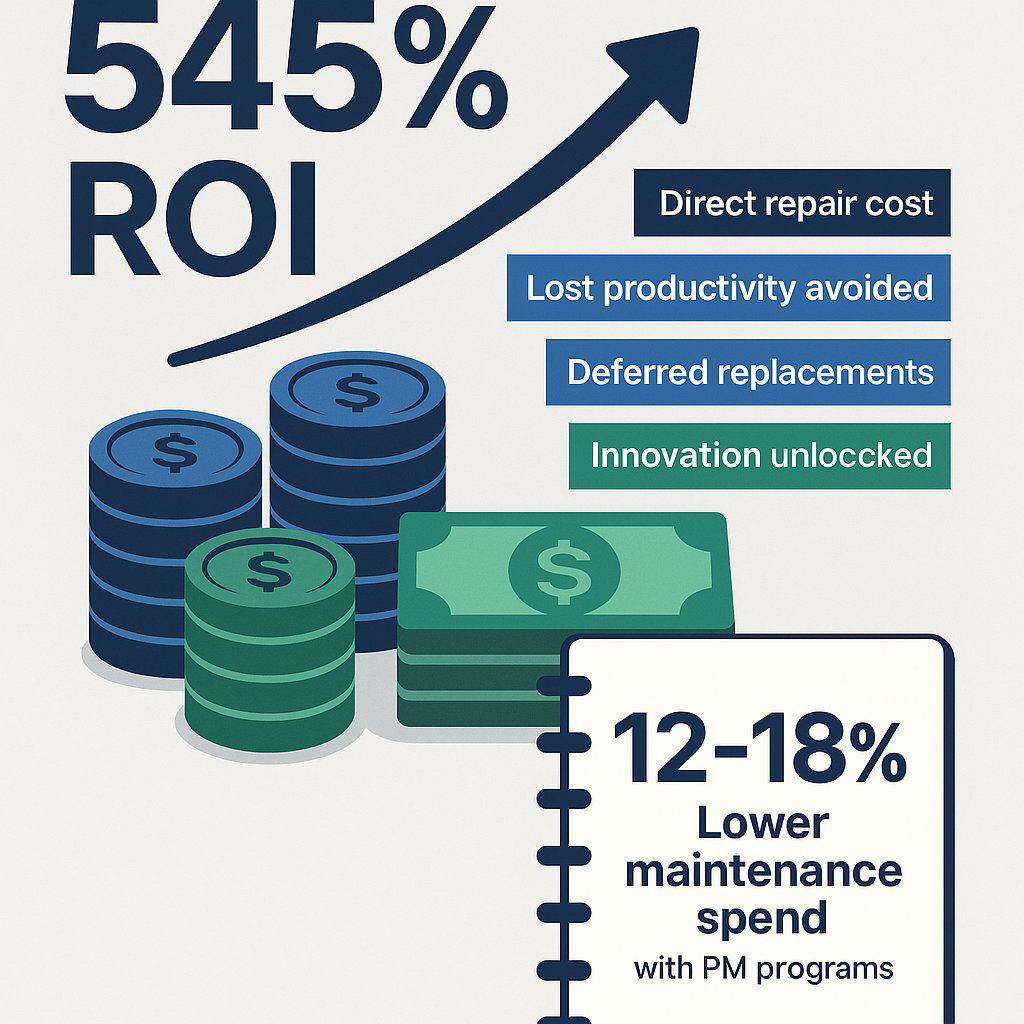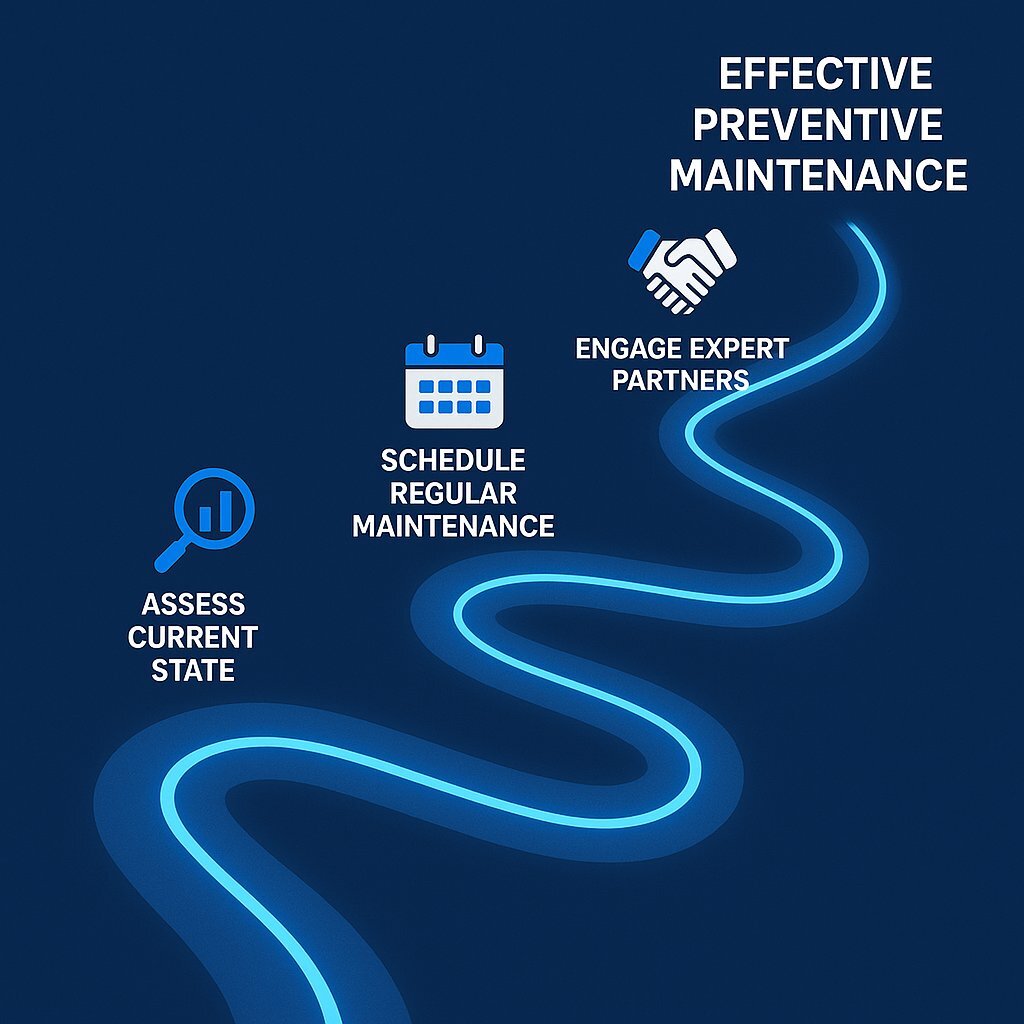
The Essential Guide to Preventive Maintenance
November 10, 2025 / Bryan ReynoldsWhat is Preventive Maintenance for Software (And Why Should Your Business Care?)
Your software is working fine. So why would you pay a maintenance team to fix something that isn’t broken? This is one of the most common—and most dangerous—questions in business technology. The answer lies in a strategic discipline known as Preventive Maintenance.
Preventive maintenance is important because it enhances safety, reduces costs, and increases equipment lifespan by ensuring assets operate efficiently and reliably.

Preventive Maintenance (PM) is a proactive approach to software management. It involves making deliberate, planned changes to a functioning software system to prevent future problems from occurring. This isn’t about fixing bugs or responding to crashes; it’s about ensuring the software stays healthy, stable, and capable of evolving with your business. Think of it as the difference between a routine physical for a healthy patient and emergency surgery for a critical one. The goal is to reduce the risk of future failures, improve long-term maintainability, and stop the slow, silent deterioration of your most critical digital assets.
This is far more than an IT checklist item; it’s a strategic imperative that directly impacts your revenue, profitability, and competitive edge. At its core, this proactive philosophy is a cornerstone of how modern, efficient companies like Baytech Consulting deliver enterprise grade quality—not just as a one-time launch but as a sustainable advantage over the entire lifecycle of an application.
Beyond "If It Ain't Broke": The High Cost of a Reactive Maintenance Mindset
Not doing preventive maintenance doesn’t save money; it just defers costs, allowing them to grow silently until they become catastrophic. Two main threats emerge from a reactive “break-fix” mentality: the accumulation of technical debt and the financial impact of unplanned downtime. This approach is called reactive maintenance, where equipment is only fixed after it fails, often resulting in higher costs and longer downtime than preventive maintenance. Corrective maintenance—another reactive strategy— involves repairing equipment after a failure occurs and can lead to significant cost implications if not managed properly.
Deferred maintenance increases the risk of equipment failure, which can cause operational disruptions and further financial losses.
Without preventive maintenance, organizations are exposed to unexpected equipment failures, leading to emergency repairs, safety hazards, and reduced asset lifespan. If your existing software is starting to lag behind, it might even be time to consider when to build custom software that’s tailored to your evolving needs.
The Ticking Time Bomb of Technical Debt
Technical debt is the cost of rework caused by taking an easy, quick solution now instead of a better solution that would take longer. Imagine taking out a high-interest loan to rush a new feature to market. You get the feature today, but every day you delay “repayment”—the work needed to clean up the code—the interest compounds, making all future development slower, more expensive, and more prone to errors.

This isn’t a niche developer concern; it’s a massive drain on global productivity. A report from Stripe revealed that developers spend, on average, 42% of their work week dealing with technical debt and bad code. That’s $85 billion in lost opportunity cost annually worldwide. The Consortium for Information & Software Quality (CISQ) puts the total cost of poor software quality in the US even higher at $2.08 trillion .
For business leaders, this “debt” manifests in tangible, frustrating ways:
- Slower Time-to-Market : New features and updates take progressively longer to develop because engineers are constantly navigating a maze of complex, brittle code.
- Increased Bugs and Instability : Shortcuts and poorly structured code are breeding grounds for defects, leading to a frustrating user experience and a constant cycle of firefighting for your tech team.
- Decreased Developer Morale : Forcing talented engineers to spend nearly half their time wrestling with bad code is a recipe for burnout and high turnover, which further slows down projects and increases costs.
Ultimately, technical debt is a productivity killer that directly hinders the strategic goals of every department from sales and marketing to finance and operations. When teams are buried in maintenance, the challenge grows. If scaling engineering productivity is a concern, explore why it’s essential to focus on problem-solving—not just typing—within your software teams.
The Bottom-Line Impact of Software Downtime
Unchecked technical debt and lack of preventive maintenance will inevitably lead to the most visible and damaging outcome: unplanned downtime. When a critical system goes down, the business stops. The costs are immediate and severe, as downtime increases operational costs by reducing efficiency, causing lost productivity, and requiring urgent maintenance interventions.
Research from Information Technology Intelligence Consulting (ITIC) found that for 93% of enterprises, a single hour of downtime costs over $300,000 . For nearly half (48%), that figure exceeds $1 million per hour . Across all industries, the average cost for large organizations now sits at an astonishing $9,000 per minute . The cost varies by industry but the numbers are scary.

| Industry | Average Cost of One Hour of Unplanned Downtime |
|---|---|
| Retail | $1.1 Million |
| Healthcare | $636,000 |
| Finance/Brokerage | $6.48 Million |
| Telecommunications | $2.0 Million |
| Manufacturing | $260,000 (up to $2.3M for Automotive) |
| Data compiled from sources including Gartner, Siemens, ITIC, and Splunk. |
But these figures are just the tip of the iceberg. The true cost of downtime extends far beyond immediate revenue loss. Surveys reveal a cascade of consequences that impact the entire business:
- Lost Productivity (47%) : Employees can’t do their jobs, operations grind to a halt.
- Damaged Brand Equity (41%) : Customer trust is eroded, often permanently. A PwC survey found 55% of consumers won’t buy from a company after a bad experience.
- Customer Churn : Splunk found 29% of companies have lost customers directly due to downtime, and 40% of CMOs believe it impacts average customer lifetime value.
Waiting for something to break is not a strategy; it’s a gamble with odds stacked heavily against you.
The Strategic Payoff: Quantifying the ROI of Proactive Software Care
Moving from a reactive to a proactive stance is not about adding a new cost center; it’s about making a high-return investment in the stability, efficiency, and future of your business. Planned maintenance is a key part of cost-effective preventive strategies to minimize downtime and reduce repair costs. The financial and strategic benefits are clear, measurable, and compelling.

The Financial Case for Prevention
The numbers behind a preventive maintenance strategy are staggering. A Jones Lang LaSalle study which analyzed millions of square feet of property and equipment found a well-implemented preventive maintenance program yields an average Return on Investment (ROI) of 545% .
This seems an incredible return but it’s the result of a powerful multiplier effect. It’s not just about saving on one repair. The ROI is the sum of multiple financial benefits unlocked by a proactive approach:
- Avoided Direct Repair Costs : Proactive maintenance is cheaper than emergency repairs. Industry data shows reactive “break-fix” maintenance costs 3 to 5 times more than a planned preventive approach over an asset’s lifecycle.
- Avoided Lost Productivity and Revenue : A scheduled PM task might cost $500 in planned labor. A reactive repair for the same issue could cost $3,000 in direct expenses, plus an additional $10,000 in lost output from the resulting downtime. PM eliminates the vast majority of these secondary costs.
- Deferred Capital Expenditure : Just like a well-maintained car, well-maintained software lasts longer. PM extends the useful life of your software assets, delaying the need for costly replacements or complete rewrites, which frees up significant capital for growth initiatives.
- Unlocked Innovation Capacity : By systematically reducing technical debt, you reclaim the 42% of developer time that was previously lost to firefighting. This reclaimed capacity can be redirected towards innovation and building new, revenue-generating features.
Organizations with robust PM programs spend 12-18% less on total maintenance costs while increasing asset reliability and uptime.
From Code Quality to Competitive Advantage
Preventive maintenance is the process that delivers the outcome of high quality code. The business impact of this quality is huge. Research from CodeScene, which analyzed millions of lines of code against project management data, quantified the difference between healthy ("Green") and unhealthy ("Red") codebases:
- Development in Green code is twice as fast .
- Red code contains 15 times more defects .
- Task completion times in Red code have 9 times more uncertainty .
Translating these technical metrics into business value reveals a clear competitive advantage:
- For the Head of Sales : "Twice as fast" means your sales team gets new, compelling features to sell before the competition does, shortening sales cycles and increasing win rates.
- For the Marketing Director : "15 times fewer defects" means higher customer satisfaction, better app store ratings, fewer negative social media mentions, and a stronger, more reliable brand reputation.
- For the Strategic CFO : "9 times less uncertainty" means project timelines and budgets become more predictable and reliable, reducing financial risk and improving the accuracy of strategic planning.
That’s why at Baytech Consulting, our commitment to enterprise-grade quality is not just about writing nice code. It’s a disciplined methodology designed to deliver these measurable business benefits, so our clients get a sustainable long term return on their technology investment. Powering this is a shift away from rigid, monolithic platforms and towards composable architecture—future-proofing your enterprise through modular, maintainable systems.
The 4 Pillars of a Powerful Preventive Maintenance Program

While the strategic “why” is compelling, understanding the practical “what” helps demystify the process. Preventive maintenance processes provide a systematic approach to scheduling regular inspections and repairs, to detect issues early, prevent equipment failures, and minimize downtime and repair costs.
A strong PM program is built on a few core activities to keep the software foundation strong, secure, and understandable. These activities include performing specific maintenance tasks such as code reviews, dependency updates, and security patching, as well as ongoing preventive maintenance work to keep the software healthy and reliable over time.
Code Refactoring: Strengthening Your Software’s Foundation
Code refactoring is the central activity of preventive maintenance. It is the disciplined process of restructuring existing computer code—improving its internal design and clarity— without changing its external functionality.
Think of it like reorganizing a messy, cluttered closet. All your clothes are still there and you can still wear them, but now they are logically arranged, easy to find, and there’s space to add new items without creating chaos. Refactoring is the primary way to “pay back” technical debt. By simplifying complex logic, removing duplicate code, and improving readability, it makes the entire system easier to understand, safer to update, and less likely to break when new features are added. Common examples of preventive maintenance in software are code cleanup, updating dependencies, and optimizing performance to prevent future issues. These preventive maintenance examples help to avoid unexpected failures and ensure the long-term stability of your applications. Common examples are breaking down long and complex functions into smaller, single-purpose ones (a technique called “Extract Method”) or consolidating redundant code blocks to follow the “Don’t Repeat Yourself” (DRY) principle.
Documentation, Optimization, and Security
Beyond refactoring, a comprehensive PM program includes several other essential activities. Regular maintenance is key to software reliability, to keep your systems robust and efficient over time:
- Documentation : Up-to-date documentation is the blueprint of your digital asset. Without it, developers waste countless hours trying to figure out how the system works, which slows down any future maintenance or enhancement work. Keeping documentation current is a vital preventive measure and should be scheduled as part of regular and periodic maintenance activities.
- Optimization : This includes a range of tasks to ensure peak performance. Tasks like optimizing slow database queries, updating third-party libraries and frameworks to their latest stable versions, and monitoring system performance are essential for efficiency and stability. Scheduling these tasks as part of regular and periodic maintenance ensures they are done at regular intervals, regardless of system condition, to prevent performance degradation. Those looking for maximum scalability and innovation should also consider the role played by low-code and custom development in routine software health.
- Security : Proactive security is non-negotiable in modern software maintenance. Applying security patches, running vulnerability scans, and updating security certificates are not separate tasks but part of a PM strategy to protect the asset from external threats. Regular and periodic maintenance routines ensure these security measures are addressed consistently. To learn more about holistic software security, check out our thoughts on why DevSecOps is now essential for modern security and growth.
Common Challenges in Preventive Software Maintenance
While the benefits of preventive maintenance for software are clear—reduced downtime, lower repair costs, and extended asset life—implementing a preventive maintenance program is not without its challenges. Maintenance teams face a complex landscape of competing priorities, evolving technologies, and resource constraints.
One of the biggest hurdles is anticipating equipment failures before they impact operations. Even with regular preventive maintenance tasks, equipment downtime and costly repairs can still happen if issues are not detected. This is where predictive maintenance comes in. By using advanced analytics and machine learning, predictive maintenance allows maintenance teams to analyze usage data and system health indicators to anticipate equipment failures and schedule maintenance before problems escalate. As artificial intelligence grows increasingly mainstream, training your teams to leverage new data-driven tools can make or break your strategy—see our approach to upskilling software engineers for AI to turbocharge preventive and predictive maintenance efforts.
Another challenge is managing maintenance schedules. With different types of preventive maintenance—time-based, usage-based, and condition-based—maintenance teams must design a maintenance schedule that prevents both over maintenance and deferred maintenance. Over maintenance can lead to unnecessary maintenance costs and operational interruptions, while deferred maintenance increases the risk of severe equipment failures and costly emergency repairs. Finding the right balance requires a proactive maintenance strategy, clear prioritization of critical assets, and ongoing adjustment of maintenance schedules based on real-world performance and manufacturer recommendations.
Resource allocation is another area where maintenance teams struggle. Effective preventive maintenance programs require skilled maintenance technicians, the right tools, and spare parts. In many organizations, maintenance teams are stretched thin and it’s hard to do regular preventive maintenance without impacting other business priorities. Investing in preventive maintenance software and computerized maintenance management systems (CMMS) can help streamline maintenance management, automate scheduling, and ensure maintenance tasks are done on time and according to best practices. Workplace safety is also an important consideration. Maintenance teams must identify and mitigate safety risks associated with maintenance tasks, from implementing lockout/tagout procedures to providing personal protective equipment. Keeping workplace safe not only protects maintenance technicians but also reduces the risk of unplanned downtime due to accidents or unsafe conditions.
Staying up-to-date with manufacturer recommendations and industry best practices is key to effective preventive maintenance. As software systems and infrastructure evolve, so do the recommended maintenance processes and procedures. Maintenance teams must update their preventive maintenance plan to incorporate the latest guidance to ensure their approach remains cost effective and compliant with current standards.
Finally, organizations must recognize the importance of regular inspections and maintenance tasks—like code reviews, security audits, and system optimizations—to prevent equipment failures and reduce the need for costly emergency repairs. By including these activities in a preventive maintenance program, businesses can reduce downtime, extend asset life, and ensure continuous operation of their most critical assets.
In summary, overcoming the common challenges of preventive software maintenance requires a holistic approach that combines proactive maintenance, predictive maintenance, and effective maintenance scheduling. By using preventive maintenance software, investing in skilled maintenance technicians, and staying current with best practices, organizations can build preventive maintenance programs that reduce maintenance costs and equipment downtime and drive long-term business success and operational reliability.
How to Build a Preventive Maintenance Strategy That Works

Building a successful PM program requires a strategic mindset and discipline. When building your preventive maintenance strategy, consider the type of preventive maintenance that fits your assets and operations—time-based, usage-based, condition-based, or predictive maintenance—since each has its own benefits and applications.
It’s not about stopping progress; it’s about building a foundation that makes future progress faster and safer. Having a preventive maintenance schedule is key to ensure regular inspections and servicing, which prevents unexpected failures and reduces repair costs. Scheduled maintenance should be part of your preventive maintenance strategy to plan and allocate resources efficiently and minimize downtime.
Integrating PM into an Agile Workflow
A common misconception is that taking time for preventive maintenance activities like refactoring or updating documentation will slow down an agile development team’s velocity. The opposite is true. Neglecting these tasks is what slows teams down over time. A healthy, well-maintained codebase is what enables sustainable speed. Modern agile methodologies accept this reality. A core principle of agile development is the continuous delivery of value which is only possible if the underlying system is stable and easy to change. Many successful agile teams include PM directly into their workflow by allocating a certain percentage of each sprint (e.g. 15–20%) to “paying down” technical debt. This ensures the codebase doesn’t deteriorate over time and the team can maintain a high, predictable velocity for delivering new features. For a deeper look at maximizing output, explore our five-step guide for aligning IT roadmaps with business goals, which often integrates preventive maintenance into broader strategy.
This is at the heart of Baytech Consulting’s Rapid Agile Deployment methodology. We believe true agility is a marathon, not a sprint. Our approach integrates proactive maintenance into the development lifecycle so the speed we deliver today doesn’t create a technical bottleneck that slows you down tomorrow.
The Role of an Expert Partner
For many organizations, internal development teams are already stretched thin, focused on building the core features that drive the business. Implementing a disciplined PM program requires specialized skills, dedicated time, and an objective perspective that can be hard to cultivate internally. Key roles such as the maintenance technician are essential for effective preventive maintenance, handling routine checks, and ensuring system reliability.
This is where working with an expert partner provides an advantage. Engaging a firm like Baytech Consulting provides a Tailored Tech Advantage . Our teams of highly skilled engineers can perform a comprehensive assessment of your existing codebase, identify the most critical areas of technical debt, and design and execute a strategic preventive maintenance plan. We use advanced tools such as enterprise asset management systems to automate workflows, improve asset reliability, and enable predictive and preventive maintenance. We also implement a computerized maintenance management system to streamline preventive maintenance processes, scheduling, and integrate with technologies like IoT and AI to optimize operational efficiency. This proactive management of your software’s foundation frees up your internal team to focus on what they do best: innovating and driving your business forward with the confidence their work is built on solid, scalable ground.
Frequently Asked Question: How Do We Budget for Preventive Maintenance?
This is a big question for any business leader considering a proactive approach. The key is to shift the mindset from viewing maintenance as a reactive “cost” to an intentional “investment” in the long-term value and viability of your software assets—just like you would budget for the upkeep of a physical factory, fleet maintenance for vehicles and machinery, or regular inspections and servicing of an HVAC system. While every application is unique, there are several industry-standard models to use as a baseline for budgeting:
- The 15% Rule for IT Budgets : Research from Accenture on digital transformation found that leading companies— those with lower-than-average technical debt and higher revenue growth—allocate, on average, 15% of their total IT budget to tech debt remediation and modernization. This is a healthy balance between funding new innovations and the long-term health of the technology estate.
- Percentage of Initial Development Cost : A common rule of thumb in the software industry is to budget between 15% and 25% of the initial development cost for annual maintenance . This budget covers all types of maintenance (corrective, adaptive, perfective, and preventive). A strategic allocation within this budget ensures preventive activities are consistently funded.
- The Asset Value Model : In the world of physical asset management, a common practice is to budget 1–3% of an asset’s total replacement value for annual preventive maintenance. While calculating a “replacement value” for custom software can be more complex, this model provides a useful mental framework for a CFO to think about the investment relative to the asset’s overall worth. Equipment usage is also a key factor—just as higher utilization of machinery or vehicles increases the frequency and cost of preventive maintenance, increased software usage or transaction volume can drive up maintenance needs and should be considered in your budgeting.
By budgeting a predictable, planned budget for preventive maintenance, you are choosing to avoid the much larger, unpredictable, and disruptive costs of emergency repairs and system downtime—it’s a financially sound and strategically vital decision.
Conclusion: Future Proofing Your Business, One Proactive Step at a Time
Preventive maintenance is not an optional technical luxury; it’s a business strategy for the digital age. It’s the most effective way to mitigate catastrophic risk, maximize the productivity of your valuable development resources, and build a resilient, adaptable technology foundation that can support your business for years to come. By shifting from a reactive to a proactive mindset, you turn your software from a liability into your greatest competitive advantage.
Getting started doesn’t require a massive, immediate overhaul. It begins with asking the right questions and establishing visibility. Get Your Current State : Ask your tech leaders two simple questions: "What is our current level of technical debt?" and "What percentage of our team’s time is spent on unplanned work and bug fixes versus new features?" The answers will be eye opening.
- Start Measuring What Matters : Begin tracking metrics like downtime frequency and duration and planned vs. unplanned maintenance work. What you can measure, you can manage.
Building a true preventive maintenance strategy requires expertise, discipline, and a clear vision. If you’re ready to have a solid technology foundation to match your business aspirations, let’s talk.
Further Reading
- The Real Price of Technical Debt
- The True Cost Of Downtime (And How To Avoid It)
- What is Code Refactoring Examples, Techniques, Tools, and Best Practice
- Jones Lang LaSalle. (n.d.). Preventive Maintenance Study Shows 545% ROI . MicroMain. Retrieved from https://micromain.com/preventive-maintenance-study/
- Stripe. (2018). The Developer Coefficient: Software engineering efficiency and its $3 trillion impact on global GDP . Retrieved from https://www.tiny.cloud/technical-debt-whitepaper/
- Tornhill, A. (2022, March 16). Code quality: measuring the business impact of unhealthy code . CodeScene. Retrieved from https://codescene.com/blog/measuring-the-business-impact-of-low-code-quality
About Baytech
At Baytech Consulting, we specialize in guiding businesses through this process, helping you build scalable, efficient, and high-performing software that evolves with your needs. Our MVP first approach helps our clients minimize upfront costs and maximize ROI. Ready to take the next step in your software development journey? Contact us today to learn how we can help you achieve your goals with a phased development approach.
About the Author

Bryan Reynolds is an accomplished technology executive with more than 25 years of experience leading innovation in the software industry. As the CEO and founder of Baytech Consulting, he has built a reputation for delivering custom software solutions that help businesses streamline operations, enhance customer experiences, and drive growth.
Bryan’s expertise spans custom software development, cloud infrastructure, artificial intelligence, and strategic business consulting, making him a trusted advisor and thought leader across a wide range of industries.


